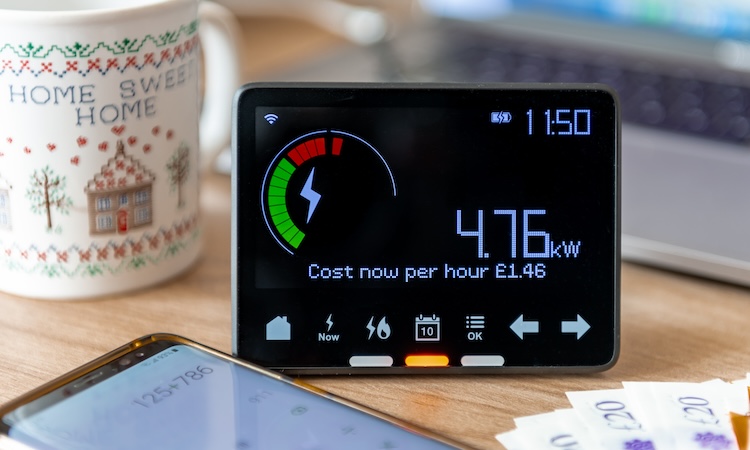After the hike in energy prices in 2022, bills have gradually been reducing again. But the most recent Ofgem energy price cap in October rose again by 10%. In this article we take a look at what this means for your energy bill, and how to cope if energy prices continue to rise.
What is the energy price cap?
The energy price cap is something that we keep hearing about. But what exactly is it?
The energy price cap is the maximum amount that energy suppliers are allowed to charge you for each unit of energy if you’re on a standard variable tariff. It also sets a maximum price for the standing charge that you pay.
The energy price cap is set by Ofgem, the regulator for the energy industry. In October the price cap for a standard variable tariff was raised to £1,717 per year from £1,568 per year, a rise of 10%. The increased prices will apply to energy bills from 1st October-31st December 2024.
It’s important to understand that even with the energy price cap, your annual energy bill could still be more than £1,717 a year. The figure of £1,717 is based on the estimated usage of a “typical household”. This typical household is assumed to:
- Use 11,500 kWh of gas and 2,700 kWh of electricity a year;
- Have a single bill for both gas and electricity;
- Pay by direct debit.
If you use more energy than the above amounts, or if your charging or payment methods are different, you could still pay more than £1,717 a year.
If you are a prepayment customer, the price cap has also risen by around 10% from £1,522 to £1,669. Ofgem continues to ensure that prepayment customers who get their gas and electricity from the same supplier pay less than direct debit customers. Standing charges have also been reduced for prepayment customers, saving around £49 a year.
Will energy prices continue to rise?
The energy price cap is reviewed every three months. The next review is due on 25th November and will affect energy prices for the period 1st January-31st March 2025. Some experts had been predicting that this price cap may go down again, but there are a number of factors that are making that look less certain.
One of the factors that affects energy prices is wholesale gas prices i.e. the amount that energy suppliers have to pay for gas themselves. Wholesale gas prices are based on supply and demand, and currently very unpredictable. This is due to a range of factors including the conflict in Ukraine, high demand for liquefied natural gas from Asia, closure of the Nord Stream 1 gas pipeline from Russia to Germany, and postponement of Nord Stream 2.
What help is available with energy bills?
The uncertainty over energy prices is made even more stressful by the recent removal of winter fuel payments to around 10 million pensioners. You can read more about this in our article How the new rules on Winter Fuel Payment affect you.
Our article also explains various other sources of help with energy bills, including The Warm Home Discount scheme, Cold Weather Payment, and Fuel Direct Scheme.
Another option to consider is changing to a fixed-rate tariff for your energy bills. A fixed-rate tariff could give you the reassurance of knowing exactly how much you have to pay each month no matter what is happening with energy prices and the energy price cap. So if you find a deal that beats the price cap, this could be an option. However, the disadvantage is that if energy prices fall, you will end up still having to pay higher prices than the new lower ones.
And always be aware that if you get into the situation where you are struggling with your energy bills, the best thing to do is to contact your supplier to see what they can do to help. They are legally required to offer you some kind of affordable payment plan or repayment holiday.
Five ways to save energy in your home
Another important way to keep your energy bills down is to find ways to save energy in your home. And this doesn’t have to mean keeping the heating off all the time and not using kitchen appliances, but just being careful about how and when you use energy. Five ideas that may help here are:
Make the most of off-peak rates
There are many energy-consuming domestic tasks that could be done during off-peak times such as after 10pm in the evenings, daytime on Sundays. Many energy suppliers now offer discounted prices at these times, and some also have additional ad hoc slots when they have lots of renewable energy available.
There are many tasks you could do during off-peak times, such as using the washing machine or dishwasher, charging appliances, or batch cooking. And if you have storage heaters, ensure that they are using a night-time Economy 7 tariff to store energy at the cheaper rate.
Turn down your thermostat
For most households, heating is the most expensive element of the energy bill. But rather than turn it off altogether, just keep it low rather than have it blasting out.
According to Citizens Advice, even turning your thermostat down by just 1°C can save around 10% on your heating costs. So it makes sense to keep the temperature slightly lower and add an extra layer of clothing if needed.
Showers tend to use less water than baths, and are even more energy-efficient if you have a water efficient shower head which reduces the amount of hot water and energy used during the shower.
Also try keeping your shower time to around 4 minutes. The Energy Saving Trust estimates that the average UK home could save between £60- £75 a year by doing this.
Be smart with your kitchen appliances
The oven is another major user of energy. But with a bit of careful planning, you can reduce the impact. For example, cook several items together to make the maximum use of your oven space, and also where possible cook food at lower temperatures. And remember the off-peak discounts we referred to earlier which you could use if you have an oven timer.
When using the washing machine and dishwasher, make sure they are both full before use so that you reduce the number of times a week they are used. The Energy Saving Trust estimates that if you reduce your washing machine use by just one cycle per week and use a lower temperature of 30°C this could save £30 a year on energy, and reducing your dishwasher use by one run per week for a year could save you £15.
Also be mindful to use smaller appliances economically. For example, if you only fill your kettle with the amount of water that you actually need, rather than filling it to the brim, it will be quicker to boil and will use less energy.
Another great way to reduce energy bills is to make sure your home is draught-free. It is pointless spending money on heating, if the hot air is just going to leak out of your home.
So check your home thoroughly for draughts, particularly around doors, windows, chimneys, ventilation panels and even gaps in the floor. If you do find a draught you need to seal it, and/or add some kind of insulating material such as draught-proofing strips, clingfilm on the windows or fabric draught excluders.
Longer-term you may want to consider getting professional draught-proofing done. Even if this means taking out a personal loan to cover the cost, it could then lead to significant savings on energy bills afterwards.
We hope that this article gives you helpful information about what is happening with energy prices and how to save energy in your home. If you are ever in urgent need of extra finances to help with energy bills, remember that Loans 2 Go offer a range of personal loans – including loans for bad credit – which may be able to help.
For more helpful financial and lifestyle tips, visit us here again soon at Loans 2 Go.


 Now is the time to start planning your financial goals for 2026
Now is the time to start planning your financial goals for 2026 
















